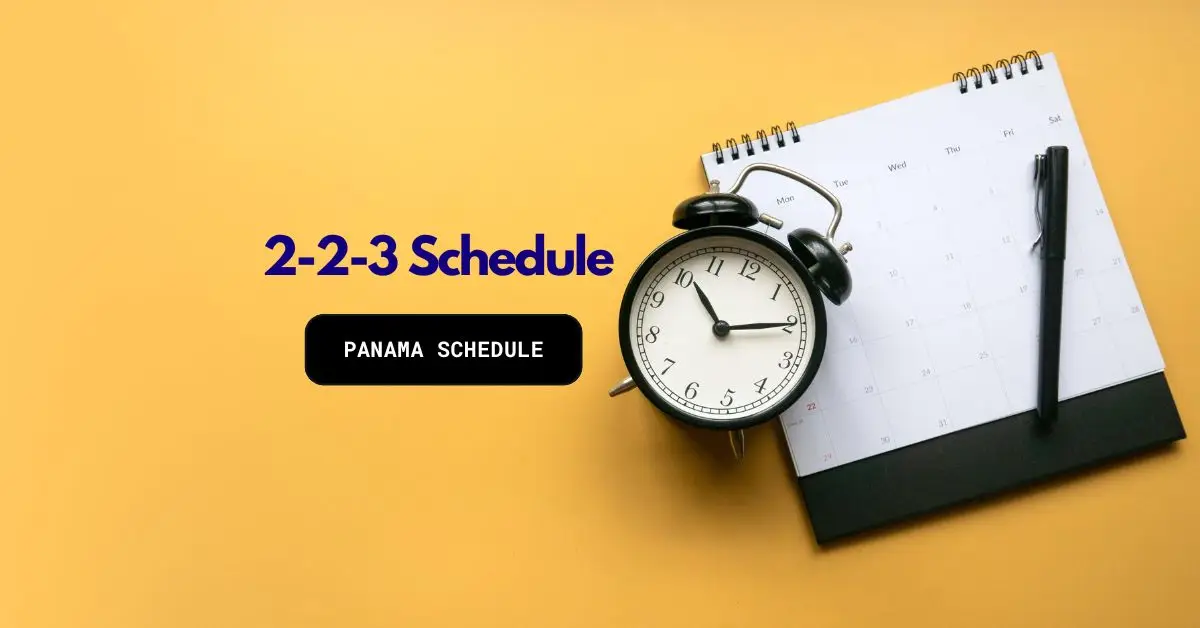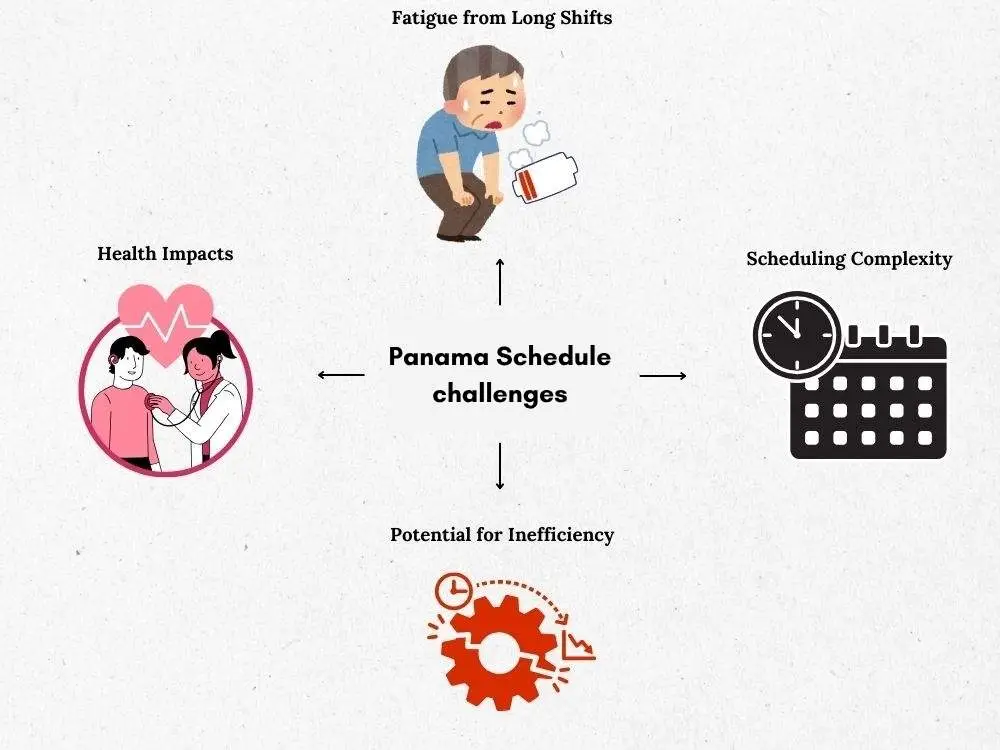
2-2-3 Schedule or Panama Schedule: Everything You Need to Know
Have you ever thought about how some organizations operate without breaks for 24 hours, 7 days a week? Employees need to work round the clock for this purpose. This is where the 2-2-3 schedule, or AKA, the Panama schedule, is used. It maintains a fair situation in scheduling employee work time.
This scheduling is more beneficial for employees working in different shifts in an organization. So, what exactly is the deal with this 2-2-3 schedule? It's an easy method of controlling shift workers and ensuring they get enough off-days from work.
In this article, we will discuss the following things:
- What the 2-2-3 schedule really means
- What are the good and bad sides of this schedule
- How to implement it effectively
- How AI tools can help
What is the 2-2-3 or Panama Schedule?
The 2-2-3 schedule follows a specific pattern of shifts and ensures continuous operation of 24/7 facilities. A worker will work for two consecutive days, off for another two, then three working days to complete the cycle. This cycle is repeated over a month, which ensures full coverage without sacrificing too much for the rest of the workers.
This is what the 2-2-3 shift looks like for an employee:
2-2-3 Panama Schedule Table (4 Weeks):
| Week | Mon | Tue | Wed | Thu | Fri | Sat | Sun |
|---|---|---|---|---|---|---|---|
| Week 1 | Work | Work | Off | Off | Work | Work | Work |
| Week 2 | Off | Off | Work | Work | Off | Off | Off |
| Week 3 | Work | Work | Off | Off | Work | Work | Work |
| Week 4 | Off | Off | Work | Work | Off | Off | Off |
- Week 1: The employee works 2 days (Mon, Tue), gets 2 days off (Wed, Thu), and then works 3 days continuously (Fri, Sat, Sun).
- Week 2: Employee starts with 2 days off (Mon, Tue), 2 days of work (Wed, Thu), and then gets 3 days off (Fri, Sat, Sun).
- Week 3: It follows the same pattern as Week 1.
- Week 4: It follows the same pattern as Week 2.
After covering 4 weeks, there are still 2 or 3 remaining days in the month where an employee covers one or two more working days to complete 15/16 work days in a month. This is okay because they generally cover 12-hour shifts.
This schedule allows employees to have regular extended periods off while ensuring round-the-clock coverage with alternating workdays and off days.
Benefits of the 2-2-3 (Panama) Schedule

a) Improved Work-Life Balance
The Panama schedule is convenient for most of the employees because it has regular extended offs. This can improve their work-life balance. Additionally, the 2-2-3 schedule gives employees every other weekend off, which is a significant benefit for maintaining personal and family time.
b) Increased Employee Satisfaction
Since this schedule comes with built-in rest periods, employees experience less burnout and fatigue compared to traditional shift schedules. This predictable nature of the 2-2-3 schedule allows for better personal planning. This helps increase job satisfaction and retention rates.
c) Optimized Productivity
In many industries like healthcare, manufacturing, and security, continuous operations are critical. Here, the Panama schedule ensures that businesses can operate efficiently without gaps in coverage. So, it helps reduce the strain of having employees work back-to-back long shifts and maintains overall productivity.
d) Flexibility in Shift Planning
Employees get more flexibility because of the alternating shift pattern. Also, it helps businesses plan around varying labor demands. During busy periods, shifts can be adjusted to manage workloads without compromising on rest periods.
e) Convenient for Long-Distance Employees
Since this work schedule offers long vacations or off-days, employees who are from a long distance (out-of-state) have the convenience to travel to their hometown and spend their off time with their family and friends, which isn't available in traditional work schedules. Also, check how to set out-of-office email when taking off days.
Challenges of the 2-2-3 Schedule

Even though the 2-2-3 schedule offers many benefits, it also comes with certain challenges. Let's see them:
a) Fatigue from Long Shifts
This work schedule mostly comes with long shift hours (12 hours) and can lead to employee burnout. This is especially true for employees who aren’t familiar with longer workdays. Moreover, the extended work hours may also impact productivity toward the end of a shift.
b) Impact on Health
The shift's nature is generally rotating between day and night, which can disrupt the employees' sleep patterns. This may lead to potential health issues over time. Therefore, both employees and management must be aware of the risks and take necessary measures to mitigate them.
c) Scheduling Complexity
Managers may face challenges to ensure that adequate employees are available for each shift while allowing for enough rest. So, proper planning and coordination are important to avoid overstaffing or understaffing during critical periods.
d) Potential for Inefficiency
Some businesses may find the Panama schedule difficult because of maintaining consistency for tasks that need daily attention. A rotating shift could create gaps in responsibility, or employees need to follow up on tasks that span multiple days.
Industries That Commonly Use the Panama Schedule
This schedule is commonly used in industries that require 24/7 operations. Some of these sectors that embrace this particular working roster include:
- Healthcare: Hospitals and other emergency services find this schedule more beneficial.
- Manufacturing: Many manufacturing plants work on a 24-hour basis due to production requirements.
- Security: Security services, especially those whose duty is to protect sensitive areas, require monitoring at all times.
- Public Safety: Firefighters, police officers, and emergency services follow similar work schedules to ensure all-time coverage.
How to Implement the 2-2-3 Schedule Effectively

Organizations are required to plan carefully for implementing the Panama schedule. Let's see some tips for managing it successfully:
1. Use Scheduling Tools
Modern scheduling tools help simplify and manage shift patterns and rotations. By automating schedules, firms ensure that shifts are distributed fairly and avoid human errors.
2. Communicate with Employees
It's vital to communicate transparently with the employees when implementing any shift schedule. This is necessary because employees should understand how the rotation works and what to expect. Providing advanced schedules also helps them plan their personal lives more effectively.
3. Monitor Health and Productivity
Managers should keep an eye on employee health, productivity, and overall morale. They should offer wellness programs or resources, like access to counseling or sleep management tips. These things can help maintain a healthy and productive workforce, which boosts employee engagement.
4. Adjust Based on Feedback
The 2-2-3 schedule might need adjustment based on operational needs or employee feedback. So, regular reviews of the schedule can help address any concerns or inefficiencies that arise.
How AI Tools Can Enhance Scheduling and Management
Smart Tools AI can significantly enhance the management of shift schedules like the Panama schedule. Here’s how it helps:
Time Converter
Managing employees across different time zones is a critical challenge. This is even more important when coordinating a rotating shift schedule like the 2-2-3 schedule.
The Time Converter tool simplifies the process by allowing you to convert shift hours accurately between different time zones. For global teams or businesses operating across regions, this tool helps ensure that all employees stay on the same page, even when working different shifts.
Example: A manufacturing company with teams in both the US and Europe can use the Time Converter to align shifts. This will ensure seamless handoffs and minimize scheduling conflicts.
Average Calculator
The 2-2-3 schedule can sometimes result in uneven weekly hours due to the rotation of workdays. Therefore, the Average Calculator helps managers calculate the average hours an employee works per week.
This is helpful and simplifies the process of tracking labor law compliance and ensures no employee is being overworked. Additionally, this tool is also useful for managing overtime and understanding workload distribution across a team.
Example: A healthcare facility using the Panama schedule can calculate the average weekly hours of its nurses to make sure they are working within a safe and legal range while still maintaining sufficient coverage.
Wrapping Up
The 2-2-3 or Panama schedule is ideal for many businesses that operate continuously. It has many benefits to the organizations such as productivity, employee satisfaction, work-life balance, and many more. However, it also comes with certain challenges that need proper attention.
By understanding the structure and impacts of this schedule, businesses can better manage their workforce and improve overall efficiency.
FAQs
Q1: Is the 2-2-3 schedule good for all types of businesses?
Not exactly. The 2-2-3 schedule is mostly suitable for businesses that operate 24/7. For example, hospitals or factories. It might not fit companies with regular 9-to-5 hours.
Q2: How does this schedule affect work-life balance?
The Panama schedule offers more days off, but working 12-hour shifts can be tiring. It depends on how well employees handle long shifts and rest.
Q3: Can employees swap shifts with coworkers?
This is based on the company’s rules. Some places allow shift swaps, but others may require sticking to the set schedule to keep everything running smoothly.
Explore Related Posts
https://smarttoolsai.com/post/calling-out-of-work-documentation
https://smarttoolsai.com/post/how-to-call-out-of-work-professionally
.webp)